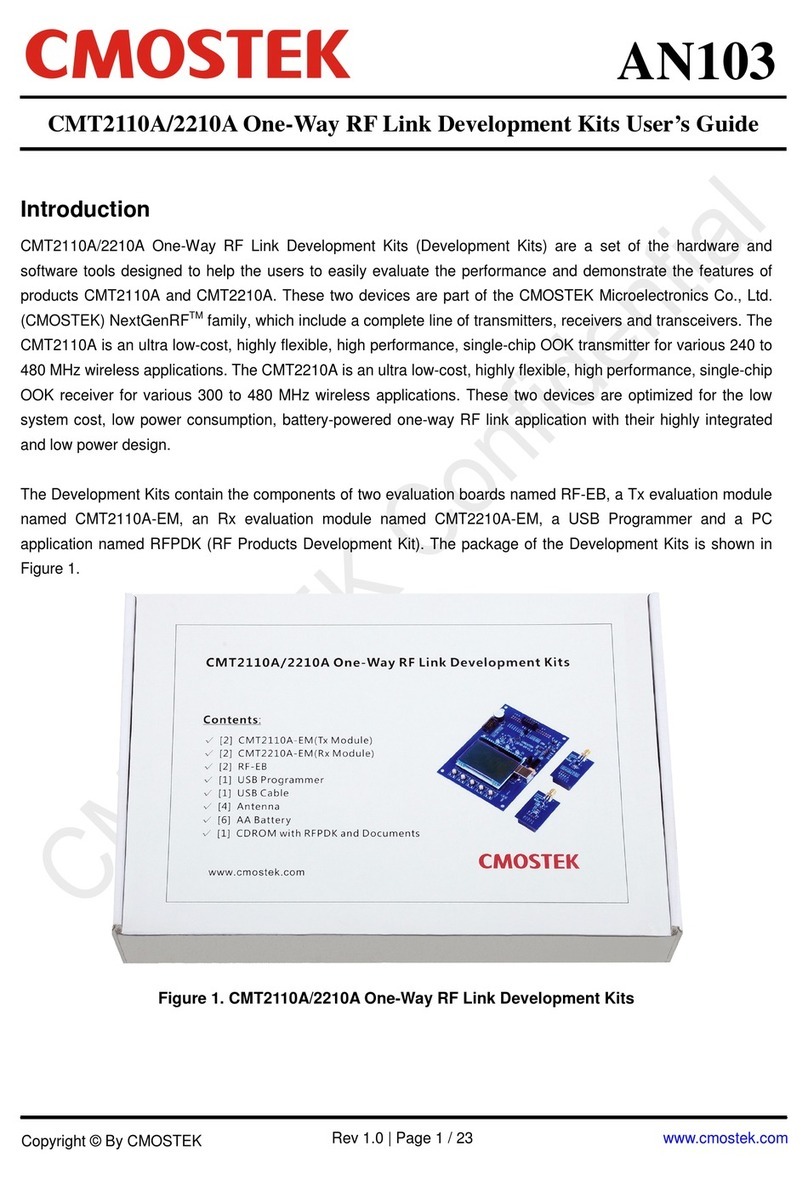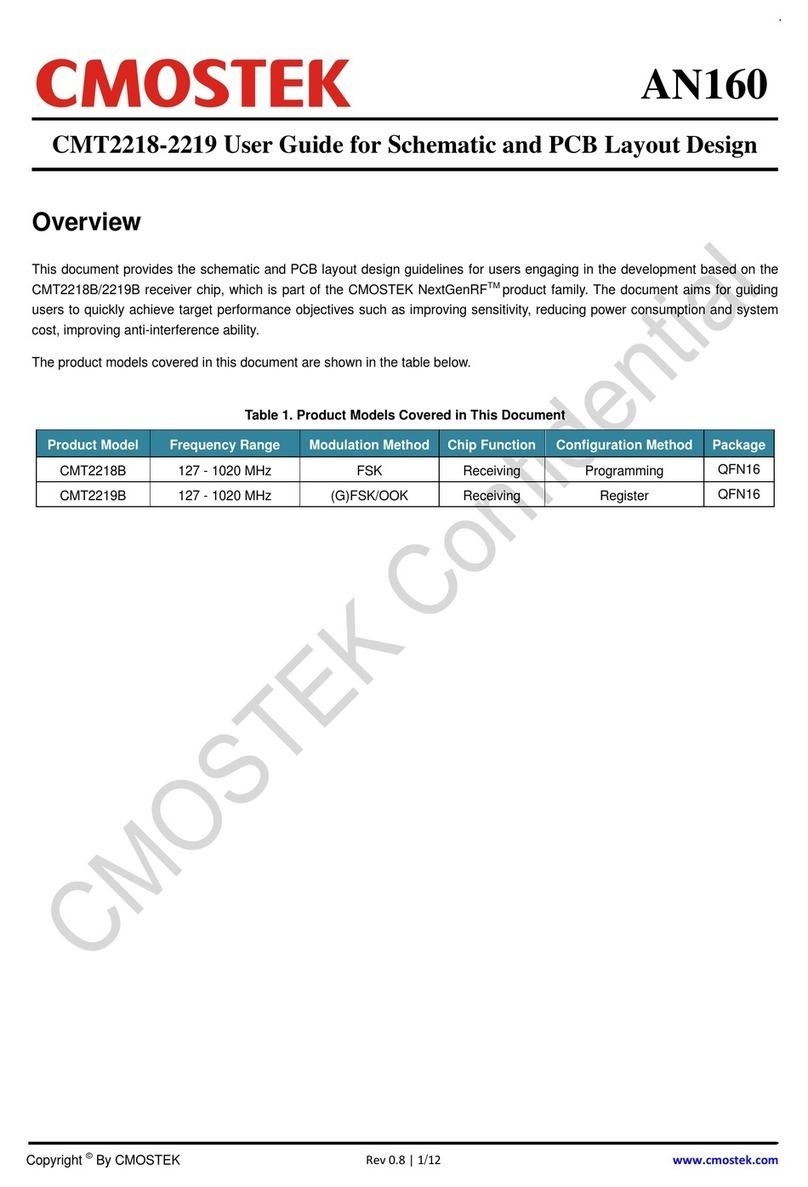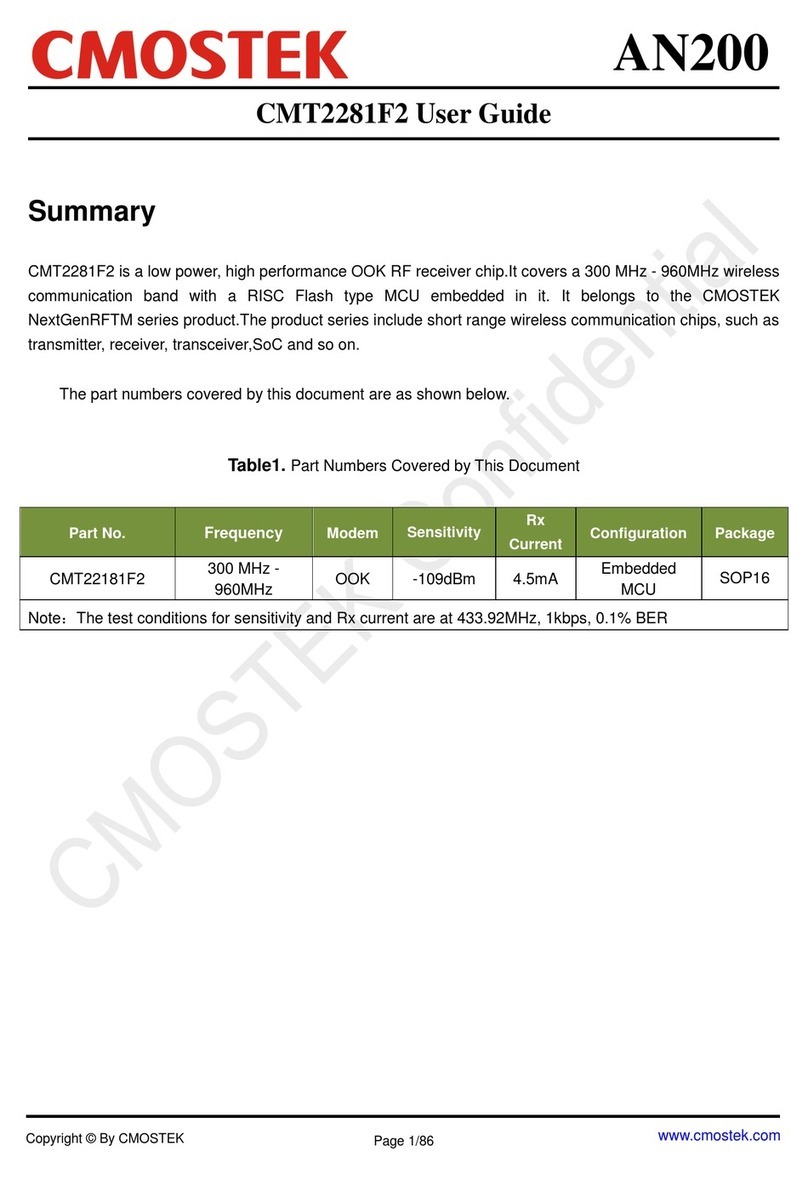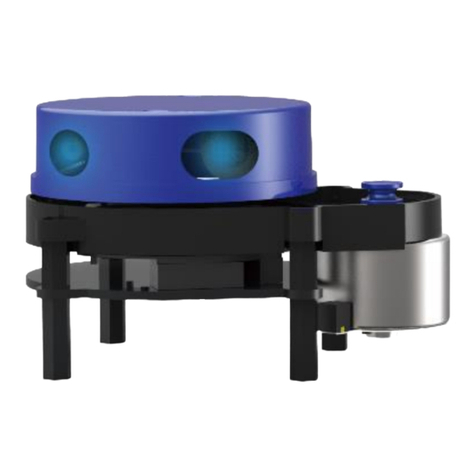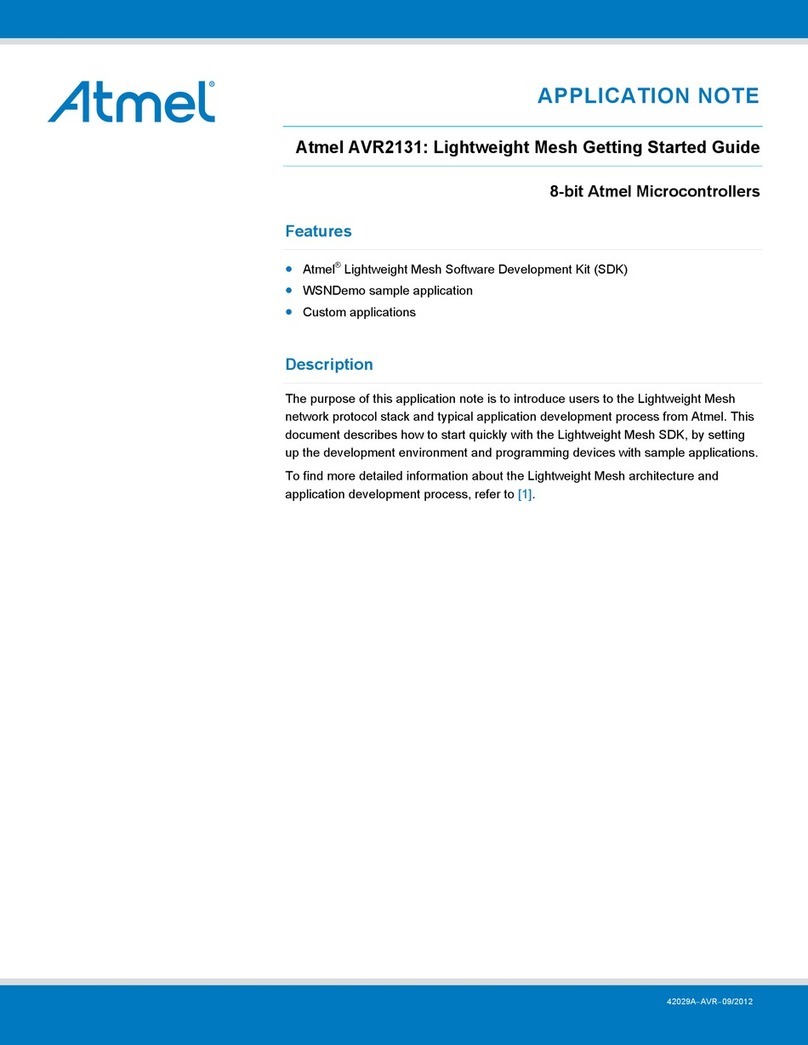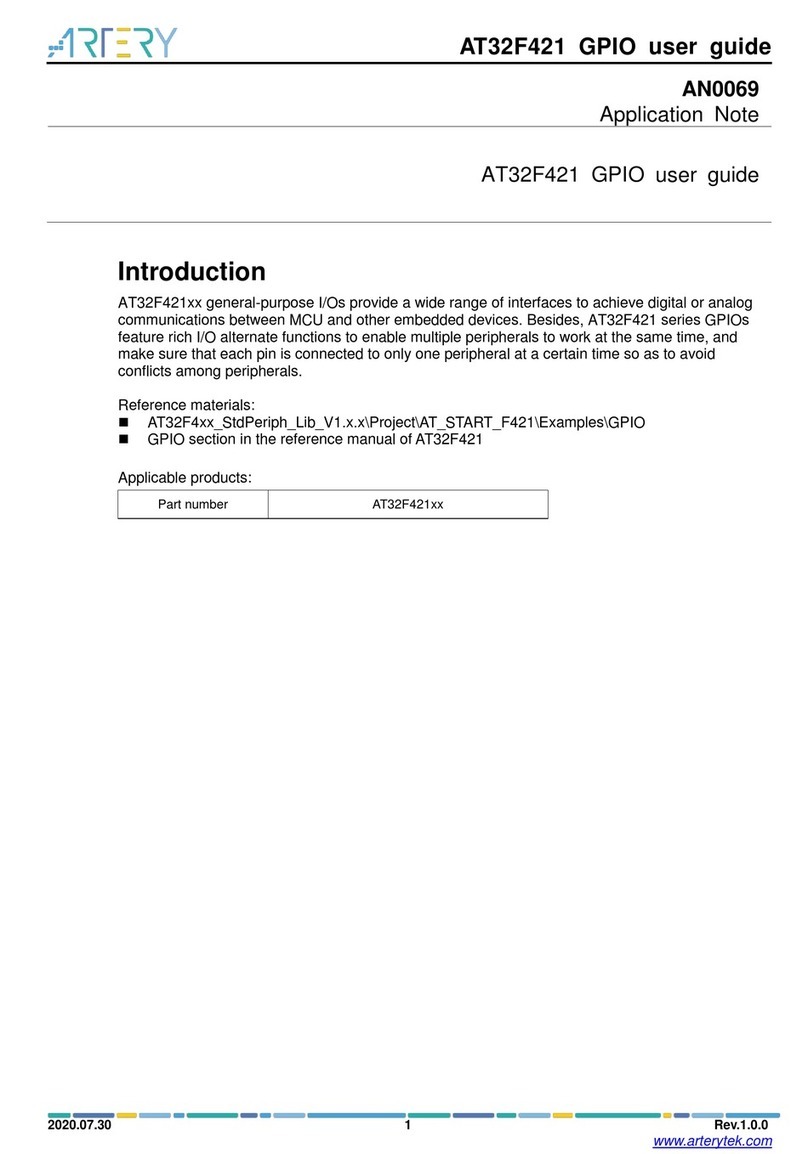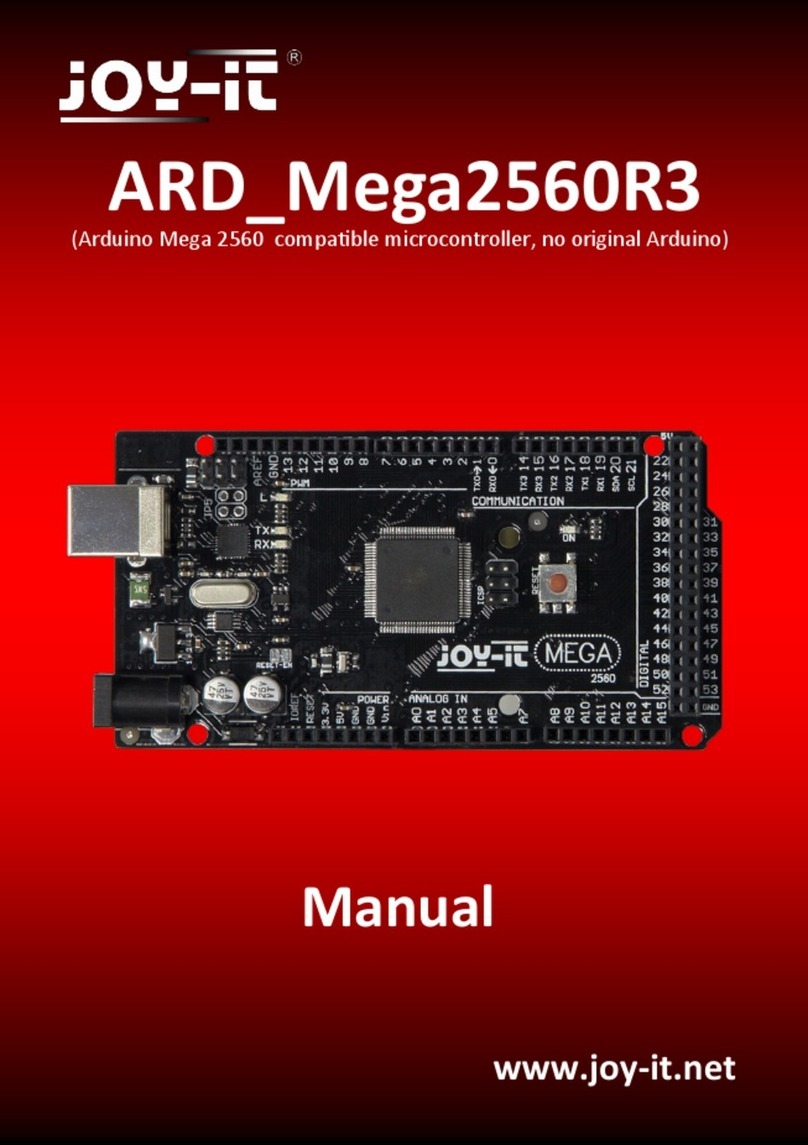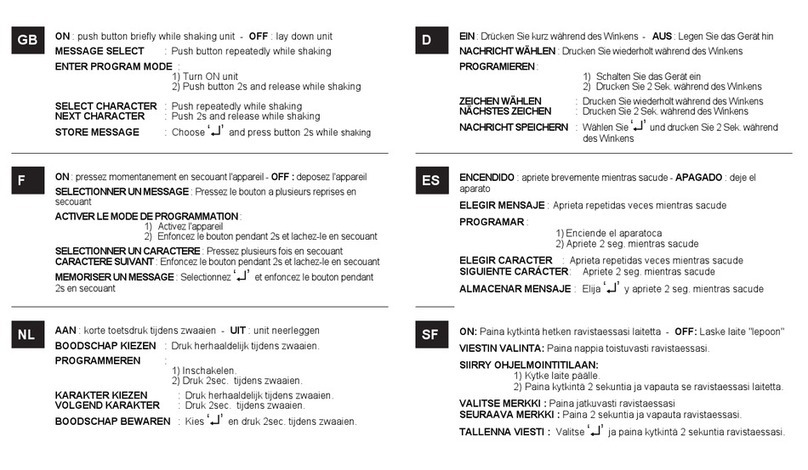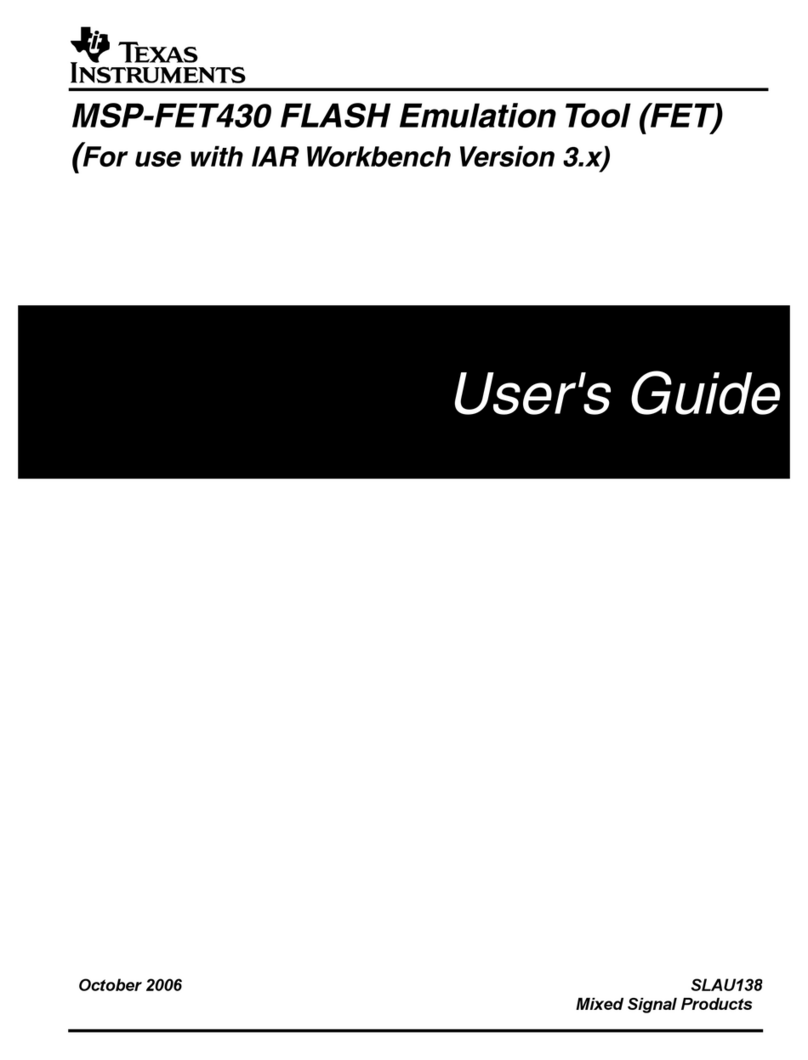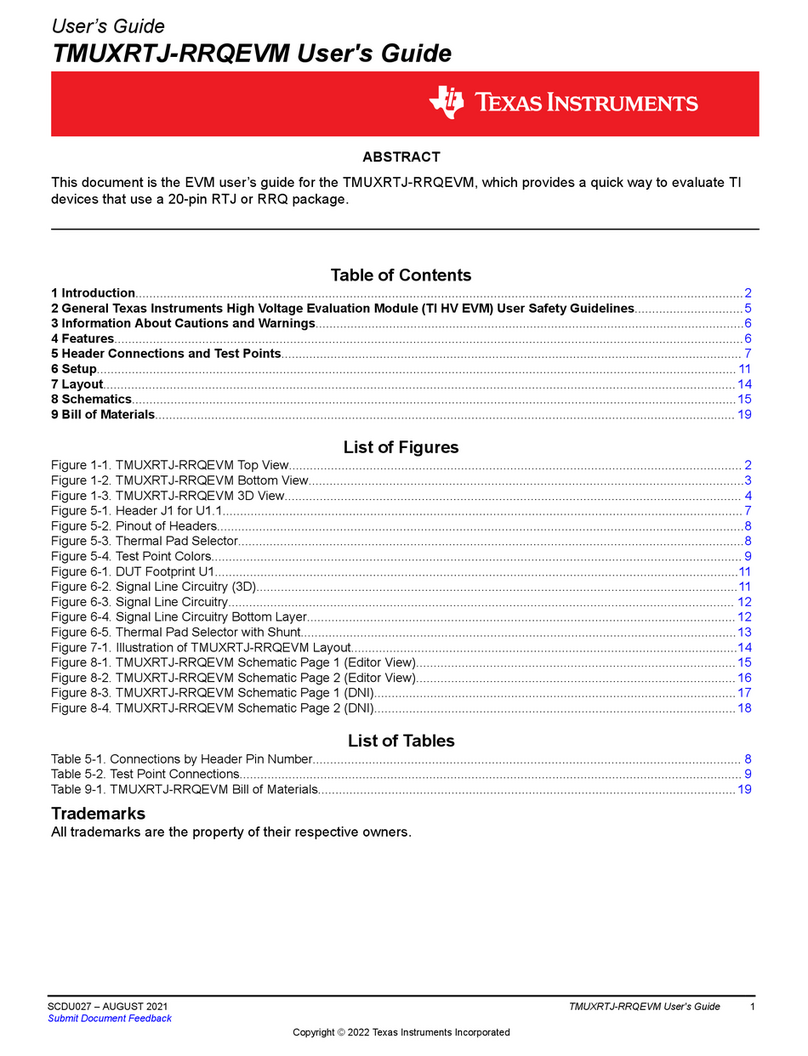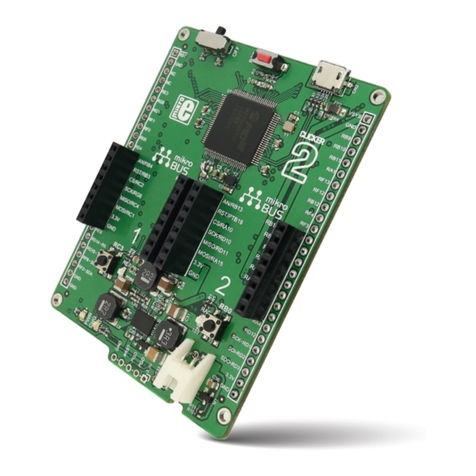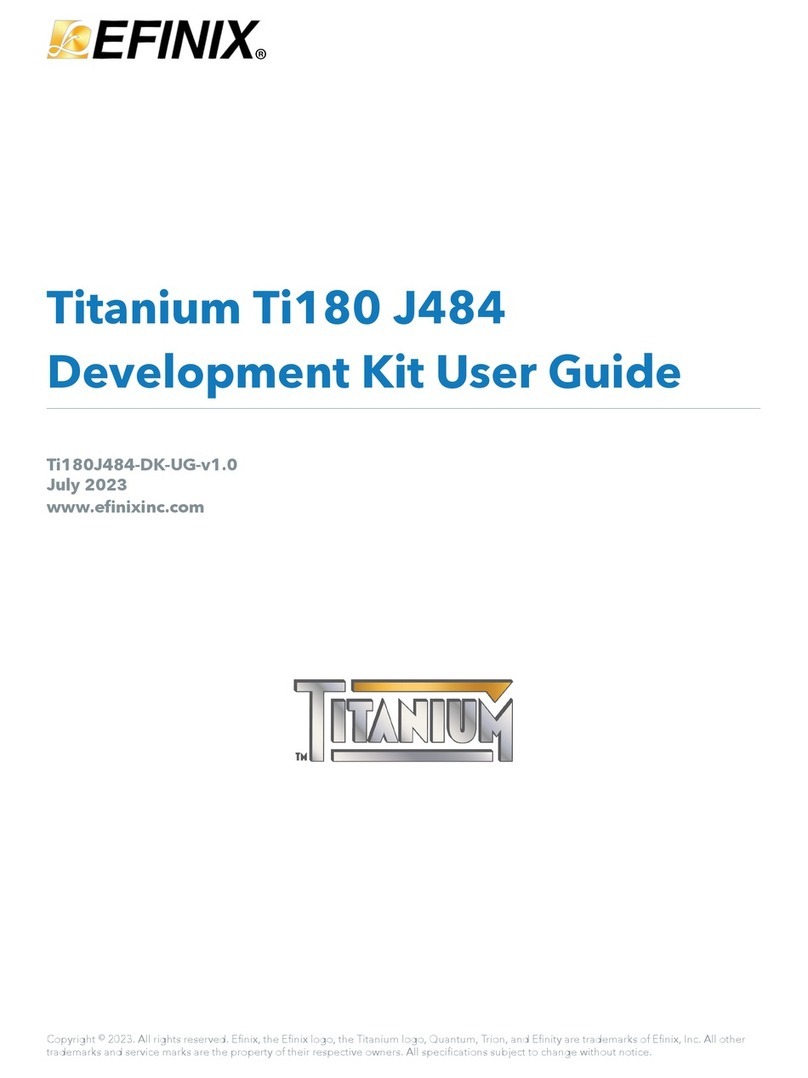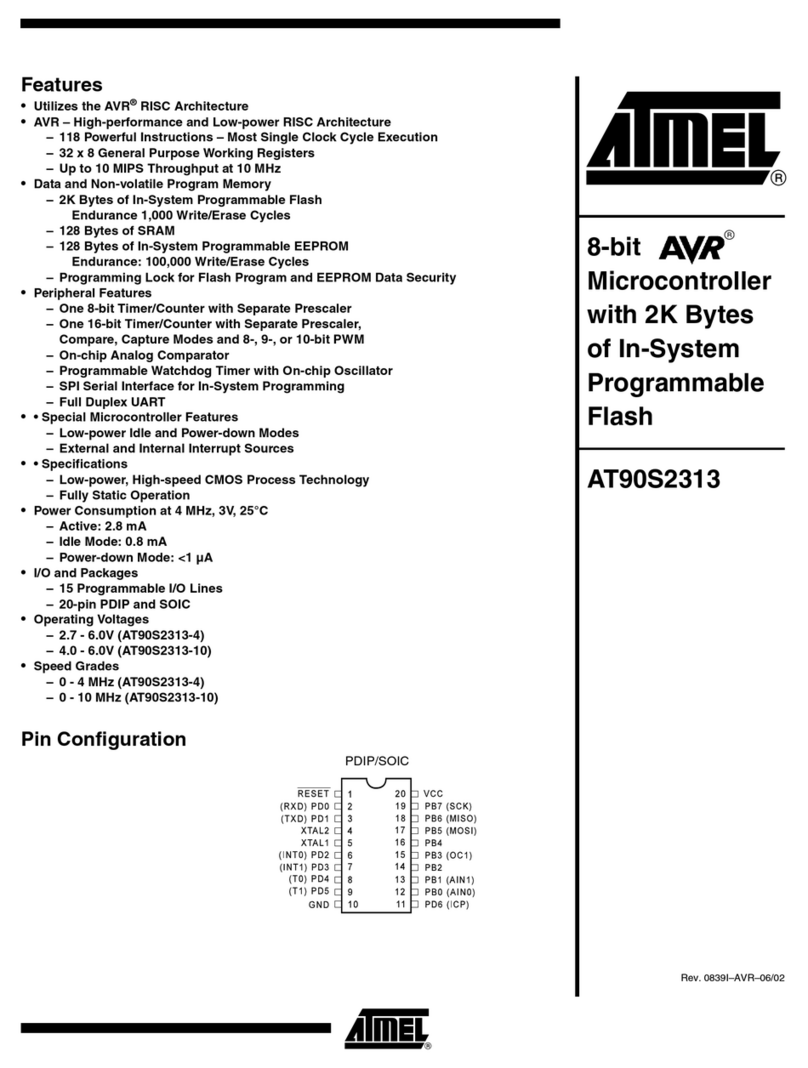CMOSTEK CMT2380F32 User manual

CMT2380F32
Rev0.9 | 1/65
www.cmostek.com
MCU Features
32 MHz Cortex-M0+ 32-bit CPU platform
32 kB Flash with erasing protection
4 kB RAM with parity to enhance system stability
16 general purpose I/O interfaces available
Flexible power management system
-0.5 uA @ 3 V(deep sleep mode): the power
consumption when all clocks are off, power-on
reset is active, I/O state is maintained, I/O
interrupt is active and all registers, RAM, and
CPU stay in data storage status
-0.8 uA@ 3 V (deep sleep mode): the power
consumption when RTCs work
-150 uA/MHz @3 V @16 MHz: the power
consumption when CPU and peripheral modules
run with program Flash operating internally
-2 us: the chip's wakeup time from ultra-low power
mode, the fast response enables mode switching
more flexible and efficient
RTC and crystal
-External high speed crystal: 4 –32 MHz
-External low speed crystal: 32.768 kHz
-Internal high speed clock: 4/8/16/22 and 24 MHz
-Internal low speed clock: 32.8/38.4 kHz
Timer and counter
-3 general purpose 16-bit timers/counters
-A 16-bit timer/counter available in low power
mode
-3 high performance 16-bit timers/counters
capable for capture/compare and PWM output
-One 20-bit programmable counter/watchdog
circuit with built-in dedicated ultra-low power
RC-OSC to perform WDT counting
Communication interface
-UART 0 and UART 1 standard communication
interface
-One ultra-low power UART(LPUART) supporting
for low speed clock
-Standard I2C and SPI communication interface
One 12-bit 1 Msps SAR ADC
2 voltage comparators
Low voltage detector (LVD), configurable 16-level
comparison level, support for port voltage and supply
voltage monitoring
RF Features
Frequency range: 127 –1020 MHz
Modem: FSK, GFSK, MSK, GMSK and OOK
Data rate:0.5 –300 kbps
Sensitivity: -121 dBm @ 434 MHz, FSK
Receiving current: 8.5 mA @ 434 MHz, FSK
Transmitting current: 72 mA @ 20 dBm, 434 MHz
Configurable up to 64-byte FIFO
System Features
Supply voltage:1.8 –3.6 V
Operating temperature: -40 –85 ℃
QFN40 5x5 packaging
Application
Smart grid and automatic meter reading
Home security and building automation
Wireless sensor networks and industrial monitoring
ISM band data communication
Description
Employed a 32-bit Cortex-M0+ CPU core and an ultra-low
power RF transceiver, the CMT2380F32 is a FSK, GFSK,
MSK, GMSK and OOK wireless MCU with high performance
and ultra-low power applying to 127 to 1020 MHz band
wireless applications. Operating with 1.8 to 3.6 V supply
voltage, the CMT2380F32 consumes only 72 mA current
while delivering up to 20 dBm power. As for the receiver, the
CMT2380F32
Ultra Low Power Sub-1GHz Wireless MCU
SoC

CMT2380F32
Rev0.9 | 2/65
www.cmostek.com
device consumes an ultra-low current of 8.5 mA with the
sensitivity reaching -121 dBm.
The device employs a wide range of peripherals like support
of standard UART, I2C and SPI interfaces, up to 16
general-purpose I/Os, support of internal high-speed,
low-speed, low-power RC oscillators and 32.768 kHz
external crystal oscillators, flexible data handling and packet
handler, up to 64-byte Tx/Rx FIFO, feature-enriched RF
GPIO, multiple low-power modes and fast-start mechanisms,
high-precision RSSI, manual fast frequency hopping,
multi-channel input 12-bit high-speed ADC, etc. Leading the
industry in the aspect of the smallest package size, the
CMT2380F32 is ideal for size constraints due to a small
form-factor, power-efficient IoT applications.

CMT2380F32
Rev0.9 | 3/65
www.cmostek.com
Table 1. The CMT2380F32 Resource List
Figure 1. Typical Application Schematic for the CMT2380F32
(20dBm Output Power with Antenna Switch)
Table 2. Typical Application BOM (20 dBm Output Power with Antenna Switch)
Label
Description
Component Value
Unit
Supplier
434 MHz
868/915 MHz
C1
± 5%, 0402 NP0, 50 V
15
15
pF
-
C2
± 5%, 0402 NP0, 50 V
10
3.9
pF
-
C3
± 5%, 0402 NP0, 50 V
8.2
2.7
pF
-
C4
± 5%, 0402 NP0, 50 V
8.2
2.7
pF
-
C5
± 5%, 0402 NP0, 50 V
220
220
pF
-
C6
± 5%, 0402 NP0, 50 V
4.7
2
pF
-
C7
± 5%, 0402 NP0, 50 V
4.7
2
pF
-
C8
± 5%, 0402 NP0, 50 V
220
220
pF
-
C9
± 5%, 0402 NP0, 50 V
220
220
pF
-
C12
± 5%, 0402 NP0, 50 V
470
pF
-
C13
± 20%, 0402 X7R, 25 V
2.2
nF
-
Memory
Analog Peripherals
Digital Peripherals
Others
ROM
RAM
ADC
VCMP
LVD
RTC
WDT
Timer
CCP
PWM
UART
LPUART
SPI
I2C
PCA
CRC
GPIO
32 k
4 k
12-bit
x9-ch
2
√
√
√
16-bit
x6
16-bit
x6-ch
2
1
1
1
√
√
16+1

CMT2380F32
Rev0.9 | 4/65
www.cmostek.com
Label
Description
Component Value
Unit
Supplier
434 MHz
868/915 MHz
C14
± 20%, 0603 X7R, 25 V
4.7
uF
-
C15
± 5%, 0402 NP0, 50 V
27
pF
-
C16
± 5%, 0402 NP0, 50 V
27
pF
-
C17
± 5%, 0402 NP0, 50 V
10
pF
-
C18
± 5%, 0402 NP0, 50 V
10
pF
-
C19
± 20%, 0402 X7R, 25 V
100
nF
-
C20
± 20%, 0603 X7R, 25 V
4.7
uF
-
C21
± 20%, 0402 X7R, 25 V
100
nF
-
C22
± 5%, 0402 NP0, 50 V
470
pF
-
L1
± 10%, 0603multilayer chip inductor
180
100
nH
Sunlord SDCL
L2
± 10%, 0603 multilayer chip inductor
27
6.8
nH
Sunlord SDCL
L3
± 10%, 0603 multilayer chip inductor
18
12
nH
Sunlord SDCL
L4
± 10%, 0603 multilayer chip inductor
33
22
nH
Sunlord SDCL
L5
± 10%, 0603 multilayer chip inductor
15
10
nH
Sunlord SDCL
L6
± 10%, 0603 multilayer chip inductor
27
12
nH
Sunlord SDCL
L7
± 10%, 0603 multilayer chip inductor
27
12
nH
Sunlord SDCL
L8
± 10%, 0603 multilayer chip inductor
68
18
nH
Sunlord SDCL
Y1
± 10 ppm, SMD32*25 mm
26
MHz
EPSON
U1
CMT2380F32, ultra-low power sub-1GHz
wireless MCU
-
-
CMOSTEK
U2
AS179, PHEMT GaAs IC SPDT Switch
-
-
SKYWORKS
R1
± 5%, 0402
2.2
kΩ
-
R2
± 5%, 0402
2.2
kΩ
-

CMT2380F32
Rev0.9 | 5/65
www.cmostek.com
Table of Contents
1Electrical Specifications..................................................................................................................... 7
1.1 Recommended Operating Conditions ................................................................................................................7
1.2 Absolute Maximum Ratings................................................................................................................................ 7
1.3 RF Power Consumption.....................................................................................................................................8
1.4 Receiver.............................................................................................................................................................9
1.5 Transmitter....................................................................................................................................................... 11
1.6 RF Operating Mode Switching Time................................................................................................................. 12
1.7 RF Frequency Synthesizer............................................................................................................................... 12
1.8 Requirement on Crystals for RF Section.......................................................................................................... 13
1.9 Controller Output Features............................................................................................................................... 13
1.10 Controller Input Features(P0, P1, P2 and P3 Reset)..................................................................................... 14
1.11 Port External Input Sampling Requirements (Timer Gate/Timer Clock)........................................................... 14
1.12 Port Leakage Features (P0, P1, P2 and P3).................................................................................................... 15
1.13 Controller Power Consumption Features ......................................................................................................... 15
1.14 POR/BOR Features.......................................................................................................................................... 18
1.15 Controller External XTH Oscillator.................................................................................................................... 18
1.16 Controller External 32.768 kHz Oscillator......................................................................................................... 19
1.17 Controller Internal RCH Oscillator.................................................................................................................... 19
1.18 Controller Internal RCL Oscillator..................................................................................................................... 20
1.19 Controller Flash Features................................................................................................................................. 20
1.20 Controller Low Power Mode Recover Time...................................................................................................... 20
1.21 Controller ADC Features.................................................................................................................................. 21
1.22 Analog Voltage Comparator............................................................................................................................. 23
1.23 Low Battery Detection Features....................................................................................................................... 25
1.24 Receive Current and Supply Voltage Correlation............................................................................................. 27
1.25 Correlation Among Receive Current, Supply Voltage and Temperature.......................................................... 27
1.26 Receive Sensitivity and Supply Voltage Correlation......................................................................................... 28
1.27 Receive Sensitivity and Temperature Correlation ............................................................................................ 29
1.28 Transmit Power and Supply Voltage Correlation.............................................................................................. 29
1.29 Phase Noise..................................................................................................................................................... 30
2Pin Description.................................................................................................................................. 31
3Chip Structure.................................................................................................................................... 37
4Sub-GHz Transceiver........................................................................................................................ 39
4.1 Transmitter....................................................................................................................................................... 39
4.2 Receiver........................................................................................................................................................... 39
4.3 Transceiver Power-on Reset (POR)................................................................................................................. 39
4.4 Transceiver Crystal Oscillator........................................................................................................................... 40
4.5 Transceiver Built-in Low Frequency Oscillator (LPOSC).................................................................................. 41
4.6 Transceiver Built-in Low Battery Detection....................................................................................................... 41
4.7 Receiver Signal Strength Indication (RSSI)...................................................................................................... 41
4.8 Phase Jump Detector (PJD)............................................................................................................................. 42
4.9 Receiver Clock Data Recovery (CDR) ............................................................................................................. 42

CMT2380F32
Rev0.9 | 6/65
www.cmostek.com
4.10 Fast Manual Frequency Hopping ..................................................................................................................... 43
4.11 Transceiver Control Interface and Operating Mode.......................................................................................... 43
4.11.1 Transceiver SPI Interface Timing.............................................................................................................43
4.11.2 Transceiver FIFO Interface Timing...........................................................................................................44
4.11.3 Transceiver Operating Status, Timing, and Power Consumption.............................................................45
4.11.4 Transceiver GPIO Function and Interrupt Mapping..................................................................................48
5Controller function Introduction...................................................................................................... 50
5.1 Cortex M0+ Core Function Description ............................................................................................................ 50
5.2 Memory............................................................................................................................................................ 53
5.2.1 On-chip Program Memory Flash..............................................................................................................53
5.2.2 On-chip Data Memory Flash....................................................................................................................53
5.3 System Clock ................................................................................................................................................... 55
5.4 Operating Mode................................................................................................................................................ 55
5.5 RTC Hardware Real Time Clock RTC.............................................................................................................. 55
5.6 General Purpose IO Port.................................................................................................................................. 55
5.7 Interrupt Controller ........................................................................................................................................... 55
5.8 Reset Controller ............................................................................................................................................... 57
5.9 Timer/Counter .................................................................................................................................................. 57
5.10 Watchdog WDT................................................................................................................................................ 58
5.11 Universal Purpose Asynchronous Receiver UART0, UART1 and LPUART..................................................... 58
5.12 Synchronous Serial Interface SPI..................................................................................................................... 59
5.13 I2C Bus ............................................................................................................................................................ 59
5.14 Buzzer.............................................................................................................................................................. 59
5.15 Clock Calibration Circuit................................................................................................................................... 59
5.16 Unique ID number............................................................................................................................................ 59
5.17 CRC16 Hardware Cyclic Redundancy Check Code......................................................................................... 59
5.18 12-bit SARADC ................................................................................................................................................ 59
5.19 Voltage Comparator (VC)................................................................................................................................. 59
5.20 LVD Low Voltage Detector (LVD)..................................................................................................................... 59
5.21 Embedded Debug System ............................................................................................................................... 60
5.22 High Security.................................................................................................................................................... 60
6Order Information.............................................................................................................................. 61
7Packaging Information...................................................................................................................... 62
8Top Marking........................................................................................................................................ 63
9Reference Documents ...................................................................................................................... 64
10 Revise History.................................................................................................................................... 64
11 Contacts ............................................................................................................................................. 65

CMT2380F32
Rev0.9 | 7/65
www.cmostek.com
1 Electrical Specifications
VDD= 3.3 V,TOP= 25 °C ,FRF = 433.92 MHz, sensitivity is measured by receiving a PN9 sequence and matching to 50 Ω
impedance, 0.1% BER if nothing else stated. All measurement results are obtained using the evaluation board CMT2380F32-EM
if nothing else stated.
1.1 Recommended Operating Conditions
Table 3. Recommended Operating Conditions
Parameter
Symbol
Condition
Min.
Typ.
Max.
Unit
Operating supply voltage
VDD
1.8
3.6
V
Operating temperature
TOP
-40
85
℃
Operating speed
CPU frequency range
256k
4M
32 M
Hz
RF supply voltage slope
VRF-PSR
1
mV/us
Controller supply voltage
Slope
VMCU-PSR
50
mV/us
Controller power-on reset
effective voltage
VMCU-POR
0.1
V
1.2 Absolute Maximum Ratings
Table 4. Absolute Maximum Ratings[1]
Parameter
Symbol
Condition
Min.
Typ.
Max.
Supply voltage
VDD
-0.3
3.6
V
Interface voltage
VIN
-0.3
3.6
V
Junction temperature
TJ
-40
125
℃
Storage temperature
TSTG
-50
150
℃
Soldering temperature
TSDR
Lasts for at least 30 seconds
Human body model (HBM)
255
℃
ESD rating[2]
Human body model (HBM)
-2
2
kV
Latch-up current
@ 85 ℃
-100
100
mA
Notes:
[1]. Exceeding the Absolute Maximum Ratings may cause permanent damage to the equipment. This value is a pressure
rating and does not imply that the function of the equipment is affected under this pressure condition, but if it is exposed
to absolute maximum ratings for extended periods of time, it may affect equipment reliability.
[2]. The CMT2380F32 is a high performance RF integrated circuit. The operation and assembly of this chip should only be
performed on a workbench with good ESD protection.
Caution! ESD sensitive device. Precaution should be used when handling the device in order to
prevent performance degradation or loss of functionality.

CMT2380F32
Rev0.9 | 8/65
www.cmostek.com
1.3 RF Power Consumption
Table 5. RF Power Consumption
Parameter
Symbol
Condition
Min.
Typ.
Max.
Unit
Sleep current
ISLEEP
Sleep mode, sleep counter off
300
nA
Sleep mode ,sleep counter on
800
nA
Standby current
IStandby
Crystal oscillator on
1.45
mA
RFS current
IRFS
433 MHz
5.7
mA
868 MHz
5.8
mA
915 MHz
5.8
mA
TFS current
ITFS
433 MHz
5.6
mA
868 MHz
5.9
mA
915 MHz
5.9
mA
FSK, RX current
(high performance)
IRx-HP
433 MHz, 10 kbps,10 kHz FDEV
8.5
mA
868 MHz, 10 kbps, 10 kHz FDEV
8.6
mA
915 MHz, 10 kbps,10 kHz FDEV
8.9
mA
FSK, RX current
(low power mode)
IRx-LP
433 MHz, 10 kbps, 10 kHz FDEV
7.2
mA
868 MHz, 10 kbps, 10 kHz FDEV
7.3
mA
915 MHz, 10 kbps, 10 kHz FDEV
7.6
mA
FSK, TX current
ITx
433 MHz, +20 dBm (Direct-tie)
72
mA
433 MHz, +20 dBm (With RF switch)
77
mA
433 MHz, +13 dBm (Direct-tie)
23
mA
433 MHz, +10 dBm (Direct-tie)
18
mA
433 MHz, -10 dBm (Direct-tie)
8
mA
868 MHz, +20dBm (Direct-tie)
87
mA
868 MHz, +20dBm (With RF switch)
80
mA
868 MHz, +13 dBm (Direct-tie)
27
mA
868 MHz, +10 dBm (Direct-tie)
19
mA
868 MHz, -10 dBm (Direct-tie)
8
mA
915 MHz, +20 dBm (Direct-tie)
70
mA
915 MHz, +20 dBm (Direct-tie)
75
mA
915 MHz, +13 dBm (Direct-tie)
28
mA
915 MHz, +10 dBm (Direct-tie)
19
mA
915 MHz, +10 dBm (Direct-tie)
8
mA

CMT2380F32
Rev0.9 | 9/65
www.cmostek.com
1.4 Receiver
Table 6. Receiver Specifications
Parameter
Symbol
Condition
Min.
Typ.
Max.
Unit
Data Rate
DR
OOK
0.5
40
kbps
FSK and GFSK
0.5
300
kbps
Error
FDEV
FSK and GFSK
2
200
kHz
Sensitivity
@ 433 MHz
S433-HP
DR = 2.0 kbps, FDEV = 10 kHz
-121
dBm
DR = 10 kbps, FDEV = 10 kHz
-116
dBm
DR = 10 kbps, FDEV= 10 kHz (low power
mode)
-115
dBm
DR = 20 kbps, FDEV = 20 kHz
-113
dBm
DR = 20 kbps, FDEV = 20 kHz (low power
mode)
-112
dBm
DR = 50 kbps, FDEV = 25 kHz
-111
dBm
DR =100 kbps, FDEV = 50 kHz
-108
dBm
DR =200 kbps, FDEV = 100 kHz
-105
dBm
DR =300 kbps, FDEV = 100 kHz
-103
dBm
Sensitivity
@ 868 MHz
S868-HP
DR = 2 kbps, FDEV = 10 kHz
-119
dBm
DR = 10 kbps, FDEV = 10 kHz
-113
dBm
DR = 10 kbps, FDEV = 10 kHz (low power
mode)
-111
dBm
DR = 20 kbps, FDEV = 20 kHz
-111
dBm
DR = 20 kbps, FDEV = 20 kHz (low power
mode)
-109
dBm
DR = 50 kbps, FDEV = 25 kHz
-108
dBm
DR =100 kbps, FDEV = 50 kHz
-105
dBm
DR =200 kbps, FDEV = 100 kHz
-102
dBm
DR =300 kbps, FDEV = 100 kHz
-99
dBm
Sensitivity
@ 915 MHz
S915-HP
DR = 2 kbps, FDEV = 10 kHz
-117
dBm
DR = 10 kbps, FDEV = 10 kHz
-113
dBm
DR = 10 kbps, FDEV = 10 kHz(low power
mode)
-111
dBm
DR = 20 kbps, FDEV = 20 kHz
-111
dBm
DR = 20 kbps, FDEV = 20 kHz (low power
mode)
-109
dBm
DR = 50 kbps, FDEV = 25 kHz
-109
dBm
DR =100 kbps, FDEV = 50 kHz
-105
dBm
DR =200 kbps, FDEV = 100 kHz
-102
dBm
DR =300 kbps, FDEV = 100 kHz
-99
dBm
Saturation
PLVL
20
dBm
Image rejection ratio
IMR
FRF = 433 MHz
35
dBc
FRF = 868 MHz
33
dBc
FRF = 915 MHz
33
dBc
Receive channel
bandwidth
BW
Receive channel bandwidth
50
500
kHz
Co-channel rejection
CCR
DR = 10 kbps, FDEV = 10 kHz
Interference with the same modulation
-7
dBc

CMT2380F32
Rev0.9 | 10/65
www.cmostek.com
Parameter
Symbol
Condition
Min.
Typ.
Max.
Unit
Adjacent channel
rejection
ACR-I
DR = 10 kbps, FDEV = 10 kHz, BW = 100
kHz, 200 kHz channel spacing,
interference with the same modulation
30
dBc
Alternate channel
rejection
ACR-II
DR = 10 kbps, FDEV = 10 kHz,
BW=100kHz, 400 kHz channel spacing,
interference with the same modulation
45
dBc
Blocking
BI
DR = 10 kbps, FDEV = 10 kHz, ±1 MHz
offset, continuous wave interference
70
dBc
DR = 10 kbps, FDEV = 10 kHz, ±2 MHz
offset, continuous wave interference
72
dBc
DR = 10 kbps, FDEV = 10 kHz, ±10 MHz
offset, continuous wave interference
75
dBc
Input 3rd order
intercept point
IIP3
DR = 10 kbps, FDEV = 10 kHz, 1 MHz and
20 MHz offset two tone test, maximum
system gain setting
-25
dBm
RSSI range
RSSI
-120
20
dBm
Sensitivity
@ 433.92 MHz
(typical
configuration)
DR = 1.2 kbps, FDEV = 5 kHz
-122.9
dBm
DR = 1.2 kbps, FDEV = 10kHz
-121.8
dBm
DR = 1.2 kbps, FDEV = 20 kHz
-119.5
dBm
DR = 2.4 kbps, FDEV = 5 kHz
-120.6
dBm
DR = 2.4 kbps, FDEV = 10 kHz
-120.3
dBm
DR = 2.4 kbps, FDEV = 20 kHz
-119.7
dBm
DR = 9.6 kbps, FDEV = 9.6 kHz
-116.0
dBm
DR = 9.6 kbps, FDEV = 19.2 kHz
-116.1
dBm
DR = 20 kbps, FDEV = 10 kHz
-114.2
dBm
DR = 20 kbps, FDEV = 20 kHz
-113.0
dBm
DR = 50 kbps, FDEV= 25 kHz
-110.6
dBm
DR = 50 kbps, FDEV = 50 kHz
-109.0
dBm
DR = 100 kbps, FDEV = 50 kHz
-107.8
dBm
DR = 200 kbps, FDEV= 50 kHz
-103.5
dBm
DR = 200 kbps, FDEV = 100 kHz
-104.3
dBm
DR = 300 kbps, FDEV = 50 kHz
-98.0
dBm
DR = 300 kbps, FDEV = 150 kHz
-101.6
dBm

CMT2380F32
Rev0.9 | 11/65
www.cmostek.com
1.5 Transmitter
Table 7. Transmitter Specifications
Parameter
Symbol
Condition
Min.
Typ.
Max.
Unit
Output power
POUT
Specific matching network is required for
different frequency bands
-20
+20
dBm
Output power step
PSTEP
1
dB
GFSK (Gaussian filter
coefficient)
BT
0.3
0.5
1.0
-
Output power change
with different
temperature
POUT-TOP
Temperature range:-40 to + 85 C
1
dB
Spurious emissions
POUT = +13 dBm,433MHz, FRF<1 GHz
-54
dBm
1 GHz to12.75 GHz, including harmonics
-36
dBm
Harmonic output[1]
for FRF= 433 MHz
H2433
2nd harmonic,+20 dBm POUT
- 46
dBm
H3433
3nd harmonic,+20 dBm POUT
- 50
dBm
Harmonic output[1]
for FRF= 868 MHz
H2868
2nd harmonic,+20 dBm POUT
- 43
dBm
H3868
3nd harmonic,+20 dBm POUT
- 52
dBm
Harmonic output[1]
for FRF= 915 MHz
H2915
2nd harmonic,+20 dBm POUT
- 48
dBm
H3915
3nd harmonic,+20 dBm POUT
- 53
dBm
Harmonic output[1]
for FRF= 433 MHz
H2433
2nd harmonic,+13 dBm POUT
- 52
dBm
H3433
3nd harmonic,+13 dBm POUT
- 52
dBm
Harmonic output[1]
for FRF= 868 MHz
H2868
2nd harmonic,+13 dBm POUT
- 52
dBm
H3868
3nd harmonic,+13 dBm POUT
- 52
dBm
Harmonic output[1]
for FRF= 915 MHz
H2915
2nd harmonic,+13 dBm POUT
- 52
dBm
H3915
3nd harmonic,+13 dBm POUT
- 52
dBm
Notes:
[1]. The harmonic level mainly depends on the matching network. Above parameters are measured based on the
CMT2380F32-EM, users may get different results on their applications.

CMT2380F32
Rev0.9 | 12/65
www.cmostek.com
1.6 RF Operating Mode Switching Time
Table 8. RF Operating Mode Switching Time
Parameter
Symbol
Condition
Min.
Typ.
Max.
Units
RF operating mode
switching time
TSLP-RX[1]
From sleep to RX
1
ms
TSLP-TX[1]
From sleep to TX
1
ms
TSTB-RX
From standby to RX
350
us
TSTB-TX
From standby to TX
350
us
TRFS-RX
From RFS to RX
20
us
TTFS-RX
From TFS to TX
20
us
TTX-RX
From TX to RX
(Needs 2Tsymbol to ramp down)
2Tsymbol
+350
us
TRX-TX
From RX to TX
350
us
Notes:
[1]. TSLP-RX and TSLP-TX are dominated by the crystal oscillator startup time, and the start-up time is to a large degree crystal
dependent.
1.7 RF Frequency Synthesizer
Table 9. RF Frequency Synthesizer
Parameter
Symbol
Condition
Min.
Typ.
Max.
Unit
Frequency range
FRF
760
1020
MHz
380
510
MHz
190
340
MHz
127
170
MHz
Frequency resolution
FRES
25
Hz
Frequency tuning time
tTUNE
150
us
Phase noise @ 433
MHz
PN433
10 kHz deviation
-94
dBc/Hz
100 kHz deviation
-99
dBc/Hz
500 kHz deviation
-118
dBc/Hz
1MHz deviation
-127
dBc/Hz
10 MHz deviation
-134
dBc/Hz
Phase noise @ 868
MHz
PN868
10 kHz deviation
-92
dBc/Hz
100 kHz deviation
-95
dBc/Hz
500 kHz deviation
-114
dBc/Hz
1MHz deviation
-121
dBc/Hz
10 MHz deviation
-130
dBc/Hz
Phase noise @ 915
MHz
PN915
10 kHz deviation
-89
dBc/Hz
100 kHz deviation
-92
dBc/Hz
500 kHz deviation
-111
dBc/Hz
1MHz deviation
-121
dBc/Hz
10 MHz deviation
-130
dBc/Hz

CMT2380F32
Rev0.9 | 13/65
www.cmostek.com
1.8 Requirement on Crystals for RF Section
Table 10. Requirement on Crystals for RF Section
Parameter
Symbol
Condition
Min.
Typ.
Max.
Unit
Crystal frequency[1]
FXTAL
26
MHz
Crystal frequency tolerance[2]
ppm
20
ppm
Load capacitance
CLOAD
15
pF
ESR
Rm
60
Ω
Crystal startup time[3]
tXTAL
400
us
Notes:
[1]. An external 26 MHz reference clock can be used to drive the XI pin directly through a coupling capacitor if such a clock
is available. The peak-to-peak level of the external reference clock is required between 0.3 and 0.7 V.
[2]. It involves:(1) initial tolerance, (2) crystal loading, (3) aging, and (4) temperature changing. The acceptable crystal
frequency tolerance is subject to the bandwidth of the receiver and the RF tolerance between the receiver and its paired
transmitter.
[3]. This parameter is to a large degree crystal dependent.
1.9 Controller Output Features
Table 11. Controller Output Features
Parameter
Symbol
Condition
Min.
Typ.
Max.
Unit
Output high level
VOH
Sourcing 4 mA current, VDD = 3.3V
VDD - 0.25
V
Sourcing 6 mA current, VDD= 3.3V
VDD - 0.60
V
Output low level
VOL
Sinking 4 mA current, VDD = 3.3V
VDD + 0.25
V
Sinking 6 mA current, VDD= 3.3V
VDD + 0.60
V
Output high level
(enhanced mode)
VOHD
Sourcing 8 mA current, VDD = 3.3V
VDD - 0.25
V
Sourcing 12 mA current, VDD = 3.3V
VDD - 0.60
V
Output low level
(enhanced mode)
VOLD
Sinking 8 mA current, VDD = 3.3V
VDD + 0.25
V
Sinking 12 mA current, VDD = 3.3V
VDD + 0.60
V
Notes:
1. The maximum total current of IOH and IOL (sum of all pins) shall not exceed 40 mA to meet the specified maximum voltage
drop.
2. The maximum total current of IOH and IOL (sum of all pins, enhanced mode) shall not exceed 100 mAto meet the specified
maximum voltage drop.

CMT2380F32
Rev0.9 | 14/65
www.cmostek.com
Figure 2. Controller I/O Driving Ability
1.10 Controller Input Features(P0, P1, P2 and P3 Reset)
Table 12. Controller Input Features(P0, P1, P2 and P3 Reset)
Parameter
Symbol
Condition
Min.
Typ.
Max.
Unit
Output high level
VIH
VDD = 1.8 V
1
1.1
1.2
V
VDD = 3.3 V
1.8
2
2.2
V
Output low level
VIL
VDD = 1.8 V
0.6
0.7
0.8
V
VDD = 3.3 V
1.1
1.3
1.5
V
Input hysteresis range
(VIH-VIL)
VHYS
VDD = 1.8 V
0.4
0.4
0.4
V
VDD = 3.3 V
0.7
0.7
0.7
V
Pull-up resistor
RPUP
Pull-up enabled
80
kΩ
Input capacitance
Sinking 12 mA current,VDD = 3.3 V
5
pF
1.11 Port External Input Sampling Requirements (Timer Gate/Timer
Clock)
Table 13. Port External Input Sampling Requirements (Timer Gate/Timer Clock)
Parameter
Symbol
Condition
Min.
Typ.
Max.
Unit
External interrupt input pulse width
TINT
VDD = 1.8 V
30[1]
ns
VDD = 3.3 V
30[1]
ns
Timer 4/5/6 capture pulse width
(FSYS=4MHz)
TCAP
VDD = 1.8 V
0.5
us
VDD = 3.3 V
0.5
us
Timer 0/1/2/4/5/6 external clock
input (FSYS=4MHz)
TCLK
VDD = 1.8 V
PCLK/2
MHz
VDD = 3.3 V
PCLK/2
MHz
PCA external input clock
TPCA
VDD = 1.8 V
PCLK/8
MHz
VDD = 3.3 V
PCLK/8
MHz
Notes:
[1]. It's the minimum external interrupt input pulse width used in the practical test for triggering the interrupt. It can support
triggering the interrupt with even shorter pulse width based on the chip capability.
Low drive
High drive
Low drive
High drive
VOL @ VDD = 3.3 V
VOH @ VDD = 3.3 V
Current (mA)
Voltage (V)
Voltage (V)
Current (mA)

CMT2380F32
Rev0.9 | 15/65
www.cmostek.com
1.12 Port Leakage Features (P0, P1, P2 and P3)
Table 14. Port Leakage Features (P0, P1, P2, and P3)
Parameter
Symbol
Condition
Min.
Typ.
Max.
Unit
Leakage current
Ilkg(Px,y)
VDD: 1.8 to 3.6V
±50
nA
Notes:
[1]. Unless otherwise specified, the leakage current is measured with GND or VDD applied to the corresponding pin.
[2]. The pin to be tested must be set to input mode.
1.13 Controller Power Consumption Features
Table 15. Controller Power Consumption Features
Parameter
Symbol
Condition
Note
Typ.
Max.
Unit
Operating current
when program
running in SRAM
IDD-RAM
VCORE = 1.55 V, VDD = 3.3 V. All
peripheral clock sources are off.
Run While(1) in SRAM with RCH
as clock source.
4 MHz
220
uA
8 MHz
400
uA
16 MHz
740
uA
24 MHz
1080
uA
32 MHz
1400
uA
Core mark operating
current
IDD-Mark
VCORE = 1.55 V, VDD = 3.3 V. All
peripheral clock sources are off.
Run Core Mark in Flash with RCH
as clock source
4 MHz
670
uA
8 MHz
1300
uA
16 MHz
2380
uA
24 MHz
3410
uA
32 MHz
Flash Wait=1
3530
uA
Operating current
IRUN
VCORE = 1.55 V, VDD = 3.3 V. All
peripheral clock sources are on.
Run While(1) in Flash with RCH as
clock source.
4 MHz
700
880
uA
8 MHz
1350
1600
uA
16 MHz
2500
3000
uA
24 MHz
3600
4300
uA
VCORE = 1.55 V, VDD = 3.3 V. All
peripheral clock sources are off.
Run While(1) in Flash with RCH as
clock source.
4 MHz
550
750
uA
8 MHz
1050
1300
uA
16 MHz
1900
2400
uA
24 MHz
2700
3300
uA
32 MHz
Flash Wait=1
2850
3000
uA
Sleep current
ISLP
VCORE = 1.55 V,VDD = 1.8~3.6 V.
4 MHz
260
280
uA

CMT2380F32
Rev0.9 | 16/65
www.cmostek.com
Parameter
Symbol
Condition
Note
Typ.
Max.
Unit
All peripheral clock sources are on
with RCH as clock source.
8 MHz
500
520
uA
16 MHz
950
970
uA
24 MHz
1400
1420
uA
VCORE = 1.55 V, VDD = 1.8 ~ 3.6 V.
All peripheral clock sources are
off. RCH clock source is used.
4 MHz
110
125
uA
8 MHz
190
210
uA
16 MHz
330
360
uA
24 MHz
470
500
uA
32 MHz
580
610
uA
LP operating current
ILP-RUN
VCORE = 1.55 V, VDD = 1.8 ~ 3.6 V.
All peripheral clock sources are
on. Run While(1) in Flash with
XTAL (32768Hz, Driver = 1) as
clock source.
TA = -40 ~ 25 ℃
7
9
uA
TA = 50 ℃
7.3
9.2
uA
TA = 85 ℃
8.9
11.3
uA
ILP-RUN
VCORE = 1.55V, VDD = 1.8 ~ 3.6 V.
All peripheral clock sources are
off. Run While(1) in Flash with
XTAL (32768 Hz, Driver = 1) as
clock source.
TA = - 40 ~ 25 ℃
6
8
uA
TA = 50 ℃
6.1
8.2
uA
TA = 85 ℃
7.7
10.1
uA
LP sleep current
ILP-SLP
VCORE = 1.55 V, VDD = 1.8 ~ 3.6 V.
All peripheral clock sources are
on. Run While(1) in Flash with
XTAL (32768 Hz, Driver = 1) as
clock source.
TA = - 40 ~ 25 ℃
3.3
3.5
uA
TA = 50 ℃
3.6
3.8
uA
TA = 85 ℃
5.4
5.8
uA
ILP-SLP
VCORE = 1.55 V, VDD = 1.8 ~ 3.6 V.
All peripheral clock sources are off
(except LPTimer and RTC). Run
While(1) in Flash with XTAL
(32768Hz, Driver = 1) as clock
source.
TA = - 40 ~ 25 ℃
2.2
2.4
uA
TA = 50 ℃
2.5
2.6
uA
TA = 85 ℃
4.2
4.6
uA
Deep sleep current
IDEEP-SLP
VCORE = 1.55 V, VDD = 1.8 ~ 3.6 V.
All peripheral clock sources are
off, except LPTimer, WDT and
RTC.
TA = - 40 ~ 25 ℃
1.5
1.65
uA
TA = 50 ℃
1.85
2.2
uA
TA = 85 ℃
3.5
4.2
uA
VCORE = 1.55 V, VDD = 1.8 ~ 3.6 V.
All peripheral clock sources are
off, except WDT.
TA = - 40 ~ 25 ℃
1.2
1.3
uA
TA = 50 ℃
1.5
1.8
uA
TA = 85 ℃
3.1
3.7
uA
VCORE = 1.55 V, VDD = 1.8 ~ 3.6 V.
All peripheral clock sources are
off, except LPTimer.
TA = - 40 ~ 25 ℃
0.9
1
uA
TA = 50 ℃
1.1
1.3
uA
TA = 85 ℃
2.6
3
uA

CMT2380F32
Rev0.9 | 17/65
www.cmostek.com
Parameter
Symbol
Condition
Note
Typ.
Max.
Unit
VCORE = 1.55 V, VDD = 1.8~3.6V. All
peripheral clock sources are off,
except RTC.
TA = - 40 ~ 25 ℃
1.0
1.1
uA
TA = 50 ℃
1.2
1.5
uA
TA = 85 ℃
2.6
3.4
uA
VCORE = 1.55 V,VDD = 1.8 ~ 3.6 V.
All peripheral clock sources are
off.
TA = - 40 ~ 25 ℃
0.42
0.6
uA
TA = 50 ℃
0.75
0.95
uA
TA = 85 ℃
2.2
2.7
uA

CMT2380F32
Rev0.9 | 18/65
www.cmostek.com
1.14 POR/BOR Features
VBOR_hys+
VBOR_hys-
unknown unknown
1.65V
1.50v
BOR_5V
VCC
Vth ~0.8v
Figure 3. POR/BOR Features
Notes:
1. POR/BOR detects the VDD voltage.
2. It detects the threshold only instead of VDD power-up and power-down slew rate.
3. The detection threshold is the same no matter the VDD is powering on or off. A reset pulse is triggered when VDD is lower
than the threshold.
4. In case a reset pulse is generated, the pulse duration will not be less than Treset to guarantee a complete system reset.
Table 16. POR/BOR Features
Parameter
Symbol
Condition
Min.
Typ.
Max.
Unit
POR release voltage (power-up process)BOR
detection voltage (power-down process)
VPOR
1.45
1.50
1.65
V
1.15 Controller External XTH Oscillator
Table 17. Controller External XTH Oscillator
Parameter
Symbol
Condition
Min.
Typ.
Max.
Unit
Crystal frequency
FFCLK
4
32
MHz
Equivalent series
resistance
ESRFCLK
32 MHz crystal
30
60
Ω
4 MHz crystal
400
1500
Ω
Load capacitance
CFCLK
The two pins of the crystal oscillator are
connected separately.
12
24
pF
Duty cycle
DCFCLK
40
50
60
%
Current consumption[1]
IDD
32 MHz crystal, CFCLK= 12 pF, ESRFCLK = 30 Ω
600
uA
Startup time
TFstart
4 MHz~32 MHz
200
400
us
Notes:
[1]. It is the current consumption when configure XTH_CR_Driver = 0b1110.
Treset
Treset
VDD

CMT2380F32
Rev0.9 | 19/65
www.cmostek.com
1.16 Controller External 32.768 kHz Oscillator
Table 18. Controller External 32.768 kHz Oscillator
Parameter
Symbol
Condition
Min.
Typ.
Max.
Unit
Crystal frequency
FSCLK
32.768
kHz
Equivalent series
resistance
ESRSCLK
65
85
kΩ
Load capacitance
CSCLK
The two pins of the crystal oscillator
are connected separately.
0
12
pF
Clock duty cycle
DCFCLK
40
50
60
%
Current consumption[1]
IDD
CSCLK =12pF,ESRSCLK = 65kΩ
0.6
1
uA
Startup time
Tstart
CSCLK =12pF,ESRSCLK = 65
kΩ,40%~60% duty cycle
500
ms
Notes:
[1]. The operating current is measured under the condition at XTL_CR_Driver = 0b0011 and ESR=65kΩ.
1.17 Controller Internal RCH Oscillator
Table 19. Controller Internal RCH Oscillator
Parameter
Symbol
Condition
Min.
Typ.
Max.
Unit
Internal high speed oscillating
frequency
FMCLK
4
4.0
32
MHz
8.0
16.0
22.12
24.0
Startup time
(not including software calibration)
TMstart
FMCLK = 4 MHz
6.0
us
FMCLK = 8 MHz
4.0
us
FMCLK = 16 MHz
3.0
us
FMCLK = 24 MHz
2.5
us
Current consumption
IMCLK
FMCLK = 4 MHz
80
uA
FMCLK = 8 MHz
100
uA
FMCLK = 16 MHz
120
uA
FMCLK = 24 MHz
140
uA
Clock duty cycle
DCMCLK
45
50
55
%
Frequency tolerance
DEVMCLK
VDD = 1.8 ~ 3.6 V,
TA = -40 ~ +85 ℃
-2.5
+2.5
%
VDD = 1.8 V ~ 3.6 V,
TA = - 20 ~ + 50 ℃
-2.0
+ 2.0
%

CMT2380F32
Rev0.9 | 20/65
www.cmostek.com
1.18 Controller Internal RCL Oscillator
Table 20. Controller Internal RCL Oscillator
Parameter
Symbol
Condition
Min.
Typ.
Max.
Unit
Internal high speed
oscillating frequency
FACLK
38.4
kHz
32.768
Startup time
TACLK
100
us
Current consumption
IACLK
0.25
uA
Clock duty cycle
DCACLK
25
50
75
%
Frequency tolerance
DEVACLK
VDD = 1.8 ~ 3.6V,
TA = - 40 ~ + 85 ℃
-2.0
+2.0
%
VDD = 1.8 ~ 3.6V,
TA = - 20 ~ + 50 ℃
-1.5
+1.5
%
1.19 Controller Flash Features
Table 21. Controller Flash Features
Parameter
Symbol
Condition
Min.
Typ.
Max.
Unit
Sector endurance
ECFlash
20
kcycles
Byte Program Time
TProg
6
7.5
us
Sector erase time
TErase
4
5
ms
Chip erase time
30
40
ms
Data retention
RETFlash
TA = +25 °C
20
Year
TA = +85 °C
10
Year
1.20 Controller Low Power Mode Recover Time
Table 22. Controller Low Power Mode Recover Time
Parameter
Symbol
Condition
Min.
Typ.
Max.
Unit
Return to active mode from
deep sleep mode
TWakeup
Regulated 1.5 V, TA = + 25°C, 4 MHz
4.0
us
Regulated 1.5 V, TA = + 25°C, 8 MHz
3.1
us
Regulated 1.5 V, TA = + 25°C, 16 MHz
2.8
us
Regulated 1.5 V, TA = + 25°C, 24 MHz
2.7
us
This manual suits for next models
1
Table of contents
Other CMOSTEK Microcontroller manuals
Popular Microcontroller manuals by other brands

PIKODER
PIKODER USB2PPM user manual
Silicon Laboratories
Silicon Laboratories C8051F12 Series manual

Bosch
Bosch XDK 110 Getting started
Silicon Laboratories
Silicon Laboratories EFM32 quick start guide

Equinox Systems
Equinox Systems Flash 8051 Getting started
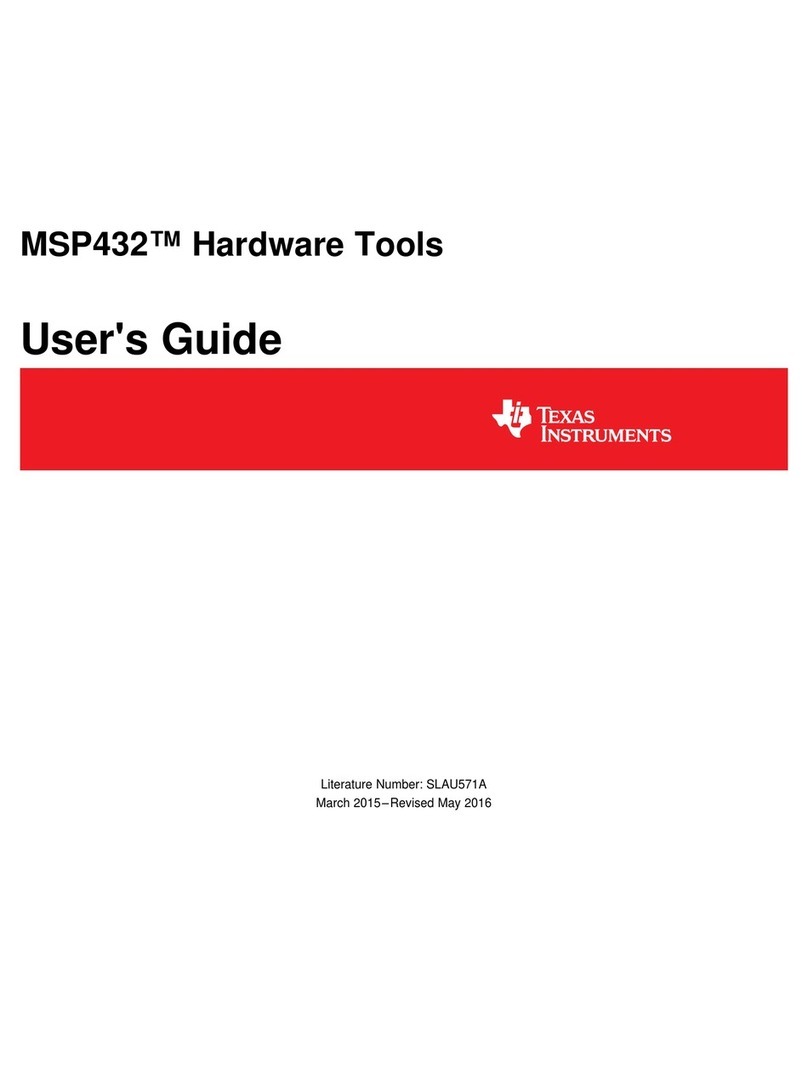
Texas Instruments
Texas Instruments MSP432 user guide
